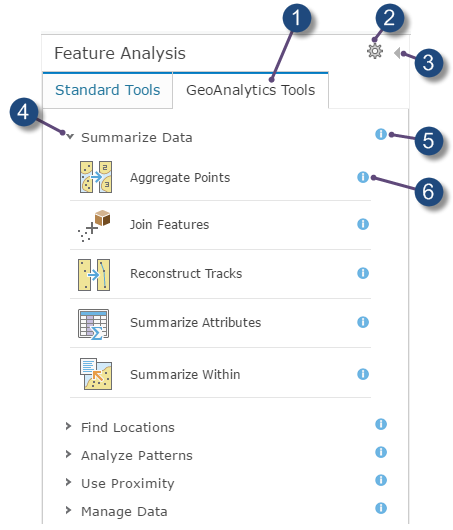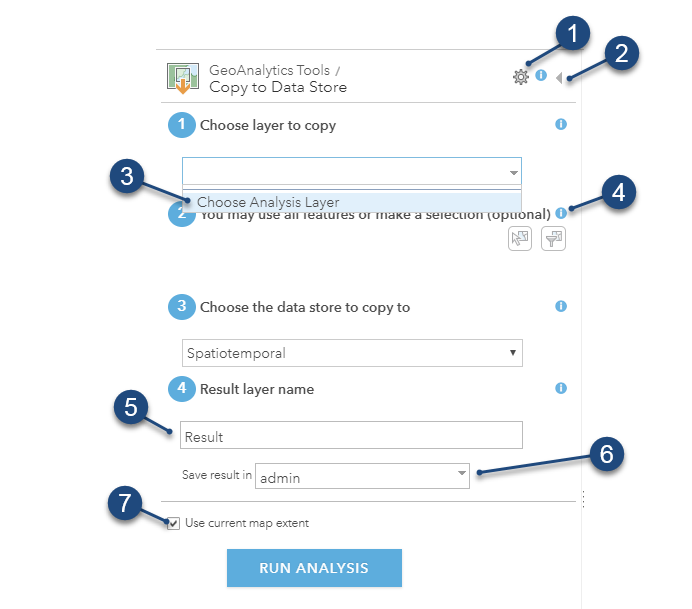Note:
This functionality is currently only supported in Map Viewer Classic (formerly known as Map Viewer). It will be available in a future release of the new Map Viewer.
The tools discussed below are the GeoAnalytics Tools tools available through your portal enabled with ArcGIS GeoAnalytics Server. For information about the standard feature analysis tools, see Perform analysis. See Analysis in ArcGIS Enterprise for an overview of each toolset.
License:
The administrator of your organization needs to enable GeoAnalytics Tools and grant you certain privileges for you to perform analysis on your big data. To use any of the tools, you need the following privileges:
- Create, update, and delete content
- Publish hosted feature layers
- GeoAnalytics Feature Analysis
If you do not have these privileges, you will not see the Perform Analysis option as described below.
To learn more about enabling GeoAnalytics Tools, see Set up ArcGIS GeoAnalytics Server.
Access GeoAnalytics Tools through Map Viewer Classic
To access and use GeoAnalytics Tools in the ArcGIS Enterprise portal's Map Viewer Classic, follow these steps:
- Open a web map in Map Viewer Classic.
You can optionally add layers to the map that you want to perform analysis on, or browse for layers when running your tools.
Note:
You cannot add big data file shares to your web map. You must browse for these layers to run analyses on them.
- Do one of the following:
- Click Analysis
 on the map menu bar.
on the map menu bar. - Alternatively, hover over the layer you want to analyze and click Analysis
 .
.
- Click Analysis
Both actions open the Perform Analysis pane.
Other ways to access GeoAnalytics Tools
In addition to accessing GeoAnalytics Tools through the portal's Map Viewer Classic, you can access tools through the following:
- ArcGIS Pro—To learn more about running GeoAnalytics Tools in ArcGIS Pro, see the ArcGIS Pro and portal tools documentation.
- ArcGIS REST API—To learn more about analysis through ArcGIS REST API, see the GeoAnalytics topic in the REST API guide.
- ArcGIS API for Python—To learn more about the analysis capabilities of the API, see the ArcGIS API for Python guide.
Explore the Feature Analysis pane
The Feature Analysis pane is illustrated below. This pane contains a number of categories and each category contains tools. To view the tools within a category, click the expand or collapse button on the left side of the category.
Note:
This example uses standard analysis and GeoAnalytics Tools. If you also have raster analysis enabled, you must choose Feature Analysis to see this pane. If you do not have standard analysis enabled, you will only see the GeoAnalytics Tools tab.

 | Choose GeoAnalytics Tools. |
 | Open the Analysis Environments dialog box. |
 | Return to the Details pane. |
 | Expand the category to view tools. |
 | View help about the category. |
 | View help for the tool. |
Work with a tool pane
To open an analysis tool pane, click the tool button. This opens the tool's pane as illustrated below with the Copy to Data Store tool.

 | Open the Analysis Environments dialog box for the tool. |
 | Close the tool pane without running the analysis and return to the Perform Analysis pane. |
 | Click Choose Analysis Layer to add a big data file share or layer in your portal. |
 | Get help about a parameter. |
 | The result of running the analysis is saved to My Content using this name. |
 | You can specify a folder in My Content in which to save the result. |
 | If checked, only the data in the current map will be analyzed. |
Note:
Analysis Environments can be set from the tool pane. Processing Extent, Processing Spatial Reference, and Data Store are used by GeoAnalytics Tools.
Each tool has a different set of parameters. You can always view help for a parameter by clicking the help button next to the parameter as illustrated above. All tools have a Result layer name parameter where the results of running the analysis are written. You can change this name or use the default value.
Use current map extent
It is recommended that you always check Use current map extent and that you zoom in to the area you want analyzed or set the Processing Extent parameter. Doing so limits the number of features the tool needs to examine when performing analysis. If you uncheck Use current map extent, all features in the analysis layer will potentially be analyzed.
Rerun analysis tools
GeoAnalytics Tools can be rerun by clicking the Rerun Analysis button  for a result layer. Rerun Analysis will open the tool that was used to create the layer and repopulate all of the parameters. The tool can be rerun with the same parameters, or the parameters can be updated before the tool is run. Ensure that the output name is unique.
for a result layer. Rerun Analysis will open the tool that was used to create the layer and repopulate all of the parameters. The tool can be rerun with the same parameters, or the parameters can be updated before the tool is run. Ensure that the output name is unique.
When rerunning, the state of the current map will be honored, including filters, extent, processing spatial reference, data store, input layers, and output folder. If you want to ensure that an analysis is rerun at a specific extent, create a bookmark. If you share your results with the intention of allowing other users to rerun your analysis, you may need to share your input layers as well. If you open a tool using Rerun Analysis and the input layers are not available, a warning will be displayed but the tool can still be run with different inputs.
Note:
The Result layer name value from the previous tool run will be used when you open an analysis tool using Rerun Analysis. You must create a unique name before rerunning a tool.
Layers and data you can analyze
Note:
Some tools only work on certain kinds of feature types; for example, Aggregate Points requires an input layer containing point features.
You have the following options when choosing a layer to analyze:
- Choose a layer from your map.
- Use Choose Analysis Layer to choose any layer in the portal to which you have access. This is the only way to select a big data file share as input to GeoAnalytics Tools.
Tip:
If you are looking for a big data file share dataset, filter using the item type Big Data File Shares.
You can perform analysis on the following types of layers and data:
- Big data file shares
- Hosted feature layers
- Hosted feature layers with views
- Feature
service
The portal must be able to access the feature service; therefore, the URL to the service must either be publicly accessible or within the same network as the portal and hosting server you use to run the analysis. You cannot perform analysis on layers based on nonaccessible feature services.
- Map service
As with feature services, the map service must be publicly accessible or within the same network as the analyzing portal and hosting server.
- Shapefile (.zip)
- Map notes
- GeoRSS web feed
Analysis output
GeoAnalytics tools you run in Map Viewer Classic can create either hosted feature layers as output or datasets in a big data file share. To learn more about setting up big data file share templates for output, see Output templates in big data file shares. All layers are analyzed in the input spatial reference unless the Processing Spatial Reference is set. By default, the output is saved to the spatiotemporal big data store, where it is stored in GCS WGS84. You can specify the big data file share template you want to write to using the analysis environments.
Note:
If you copy a layer to the relational data store using Copy to Data Store, or save the output to the relational data store using the environment settings, the output will be stored in the spatial reference it was projected to. If you save to a big data file share, the output will be in the same output as analysis, unless the template specifies an output spatial reference. Then results will be projected to that spatial reference.